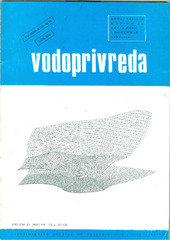Prikaz osnovnih podataka o dokumentu
Problemi pri skretanju burnog toka - kosi stojeći talas
Problems of Direction Changes in Supercritical Flow - Oblique Standing Waves
| dc.creator | Batinić, Božidar | |
| dc.creator | Milanović, Tina | |
| dc.date.accessioned | 2021-12-21T13:19:20Z | |
| dc.date.available | 2021-12-21T13:19:20Z | |
| dc.date.issued | 1997 | |
| dc.identifier.issn | 0350-0519 | |
| dc.identifier.uri | https://grafar.grf.bg.ac.rs/handle/123456789/2584 | |
| dc.description.abstract | U radu se analizira buran tok vode sa slobodnom površinom i pojave do kojih dolazi usled naglog skretanja zida kanala. Ovakve nagle promene u burnom toku dovode do pojave kosih stojećih talasa. Ovaj problem analizirao je A. Ippen. Osnovni nedostatak rešenja je što se dobijeni oblik strujnica javlja i u slučaju ukrštanja dva burna toka, pri čemu režim sa manjim Frudovim brojem skreće režim sa većim Frudovim brojem, što nije logično. Urađena je nova analiza ovog fenomena, sa novim pretpostavkama, i proverena na modelu. Po ovom rešenju, neporemećeni sloj stiže do zida, gde se vertikalno okreće i formira gornji skrenuti sloj. Urađena labaratorijska merenja pokazala su da je rešenje prihvatljivo i za kanale sa podužnim padom. Osnovna razlika između razmatrana dva rešenja je što u Ippen-ovom rešenju uzrok poremećaja može biti i zid i neki drugi tok, dok u novom rešenju poremećaj može izazvati samo čvrsta granica. Koristeći novo rešenje problema rezultat se dobija direktnim proračunom, a rezultati se bolje slažu sa eksperimentalnim rezultatima. | sr |
| dc.description.abstract | The paper deals with the supercritical flow in the channels with vertical walls, and the problem of water flow changes due to an abrupt change of the vertical channel wall. An abrupt change of channel walls in supercritical water flow results in an oblique standing wave. A. Ippen analyzed this problem. The essential objection to this solution is that the streamline pattern cannot be the consequence of the wall change only, since it also occurs by mutual crossing of two supercritical regimes. It is not logical that the regime within a smaller Froude number deflects the regime with a larger Froude number. The phenomenon was analyzed with new assumptions, and checked on a model. The undisturbed layer depth reaches the wall where it turns vertically and forms an upper deflected layer. In order to show the effects of the longitudinal fall, systematic laboratory measurement were carried out, and the results showed that the solution was also applicable to channel with a longitudinal fall. The essential difference between these two solutions is that in Ippens solution the cause of the disturbances may be both, the wall or some other flow, while according to this new solution the cause of disturbance may be only a strong boundary. Truss a new original solution is given, the results of which are in much better agreement experimental results. | sr |
| dc.language.iso | sr | sr |
| dc.publisher | Jugoslovensko društvo za odvodnjavanje i navodnjavanje | sr |
| dc.rights | openAccess | sr |
| dc.rights.uri | https://creativecommons.org/licenses/by-nc-nd/4.0/ | |
| dc.source | Vodoprivreda | sr |
| dc.subject | tečenje u kanalima | sr |
| dc.subject | buran tok | sr |
| dc.subject | poremećaji toka | sr |
| dc.subject | kosi stojeći talas | sr |
| dc.subject | water flow in channels | sr |
| dc.subject | supercritical water flow | sr |
| dc.subject | changes of water flow | sr |
| dc.subject | oblique standing wave | sr |
| dc.title | Problemi pri skretanju burnog toka - kosi stojeći talas | sr |
| dc.title | Problems of Direction Changes in Supercritical Flow - Oblique Standing Waves | sr |
| dc.type | article | sr |
| dc.rights.license | BY-NC-ND | sr |
| dc.citation.epage | 314 | |
| dc.citation.issue | 169-170 | |
| dc.citation.spage | 307 | |
| dc.citation.volume | 29 | |
| dc.identifier.fulltext | http://grafar.grf.bg.ac.rs/bitstream/id/10000/bitstream_10000.pdf | |
| dc.identifier.rcub | https://hdl.handle.net/21.15107/rcub_grafar_2584 | |
| dc.type.version | publishedVersion | sr |

